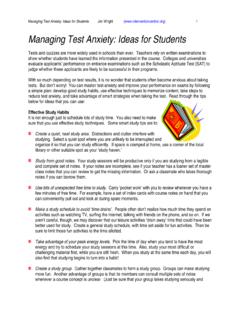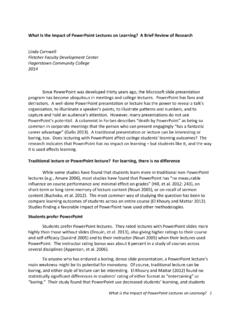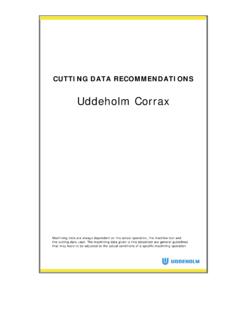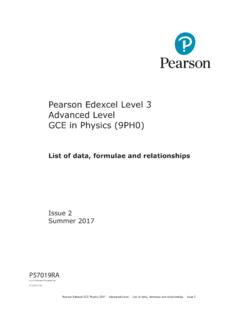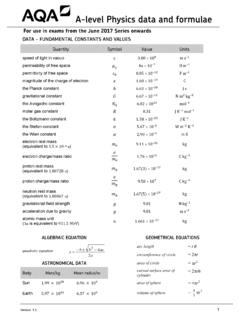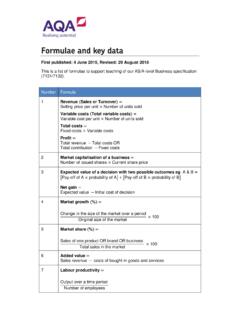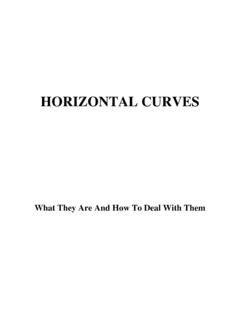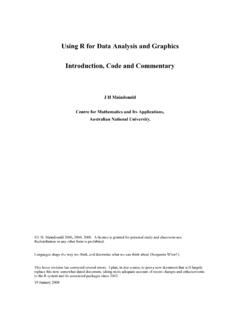Transcription of Frequently Used Statistics Formulas and Tables
1 Frequently used Statistics Formulas and Tables Chapter 2. highest value - lowest value Class Width = (increase to next integer). number classes upper limit + lower limit Class Midpoint =. 2. Chapter 3 Chapter 3. n = sample size Limits for Unusual data N = population size Below : - 2 . f = frequency Above: + 2 . =sum w = weight Empirical Rule About 68%: - to + . x About 95%: -2 to + 2 . Sample mean: x =. n About : -3 to + 3 . x Population mean: =. N s Sample coefficient of variation: CV = 100%. ( w x) x Weighted mean: x =. w . Population coefficient of variation: CV = 100%. ( f x) . Mean for frequency table : x =. f highest value + lowest value Sample standard deviation for frequency table : Midrange =. 2 n [ ( f x 2 ) ] [ ( f x) ] 2. s=. n (n 1). Range = Highest value - Lowest value x x Sample z-score: z =. ( x x ) 2 s Sample standard deviation: s =. n 1 x . Population z-score: z =.
2 ( x ) 2.. Population standard deviation: =. N. = Q3 Q1. Interquartile Range: (IQR). Sample variance: s 2. Modified Box Plot Outliers Population variance: 2 lower limit: Q1 - (IQR). upper limit: Q3 + (IQR). Chapter 4 Chapter 5. Probability of the complement of event A Discrete Probability Distributions: P (not A) = 1 - P ( A). Mean of a discrete probability distribution: Multiplication rule for independent events = [ x P( x)]. P ( A and= B) P ( A) P ( B ). Standard deviation of a probability distribution: General multiplication rules =. P ( A and B) P ( A) P ( B, given A) = [ x 2 P( x)] 2. =. P ( A and B) P ( A) P ( A, given B ). Addition rule for mutually exclusive events Binomial Distributions P ( A or B ) = P ( A) + P ( B ) r = number of successes (or x). p = probability of success General addition rule q = probability of failure = P ( A or B ) P ( A) + P ( B ) P ( A and B ).
3 Q= 1 p p + q=1. Binomial probability distribution Permutation rule: n Pr =. n! P ( r ) = n Cr p r q n r (n r )! Mean: = np n! Combination rule: n Cr = Standard deviation: = npq r !(n r )! Poisson Distributions Permutation and Combination on TI 83/84. r = number of successes (or x). = mean number of successes n Math PRB nPr enter r (over a given interval). Poisson probability distribution n Math PRB nCr enter r e r P(r ) =. r! e Note: textbooks and formula sheets interchange r and x = mean (over some interval). for number of successes = . 2 = . 2. Chapter 6 Chapter 7. Normal Distributions Confidence Interval: Point estimate error x z + . Raw score: = Point estimate = Upper limit + Lower limit 2. x . Standard score: z =. Error = Upper limit - Lower limit 2. Mean of x distribution: x = Sample Size for Estimating means: Standard deviation of x distribtuion: x =. z.
4 2. n n = /2 . (standard error) E . x . Standard score for x : z = proportions: / n z . 2. / 2 with preliminary estimate for p n = pq E . Chapter 7. 2. z . One Sample Confidence Interval n = / 2 without preliminary estimate for p E . for proportions (p) : (np > 5 and nq > 5) variance or standard deviation: *see table 7-2 (last page of formula sheet). p E < p < p + E. p(1 p) Confidence Intervals where E = z / 2. n r Level of Confidence z-value ( z / 2 ). p =. n 70% for means ( ) when is known: 75% x E < < x+E. 80% . where E = z / 2. n 85% for means ( ) when is unknown: 90% x E < < x+E 95% s where E = t / 2. n 98% with d . f .= n 1. 99% (n 1) s 2 (n 1) s 2. for variance ( 2 ) : < 2 <. R2 L2. with d . f .= n 1. 3. Chapter 8 Chapter 9. One Sample Hypothesis Testing Difference of means 1 - 2 (independent samples). Confidence Interval when 1 and 2 are known p p (x1 x2 ) E < ( 1 2 ) < (x1 x2 ) + E.
5 For p (np > 5 and nq > 5) : z=. pq / n 12 22. =. where E z / 2 +. where q =. 1 p; p =. r/n n1 n2. x Hypothesis Test when 1 and 2 are known for ( known): z =. / n ( x x ) ( 1 2 ). z= 1 2. x 12 22. for ( unknown): t= with d . f .= n 1 +. n1 n2. s/ n (n 1) s 2 Confidence Interval when 1 and 2 are unknown for 2 : 2= with d . f .= n 1. 2 (x1 x2 ) E < ( 1 2 ) < (x1 x2 ) + E. s12 s22. =E t / 2 +. Chapter 9 n1 n2. with d . f . = smaller of n1 1 and n2 1. Two Sample Confidence Intervals and Tests of Hypotheses Hypothesis Test when 1 and 2 are unknown Difference of Proportions (p1 p2 ) ( x1 x2 ) ( 1 2 ). t=. s12 s22. Confidence Interval: +. n1 n2. (p 1 p 2 ) E < ( p1 p2 ) < (p 1 p 2 ) + E with d .=. f . smaller of n1 1 and n2 1. p 1q 1 p 2 q 2. =. where E z / 2 + Matched pairs (dependent samples). n1 n2 Confidence Interval p 1 =. r1 / n1 ; p 2 =. r2 / n2 and q 1 =. 1 p 1 ; q 2 =.
6 1 p 2 d E < d < d + E. s =where E t / 2 d with = n 1. n Hypothesis Test: Hypothesis Test ( p 1 p 2 ) ( p1 p2 ). z= d d pq pq t= with d . f .= n 1. + sd n1 n2. n where the pooled proportion is p Two Sample Variances r +r Confidence Interval for 12 and 22. p = 1 2 and q = 1 p n1 + n2 s2 1 12 s12 1 . 12 < 2 < 2 . = s 2 Fright 2 s 2 Fleft . p 1 r1=. / n1 ; p 2 r2 / n2 . s12. Hypothesis Test=. Statistic: F where s12 s22. s22. numerator d . f . =. n1 1 and denominator d . f . =. n2 1. 4. Chapter 10 Chapter 11. (O E ) 2 (row total)(column total). Regression and Correlation 2 =. where E =. E sample size Linear Correlation Coefficient (r). Tests of Independence d . f . =( R 1)(C 1). n xy ( x)( y ). r=. n( x 2 ) ( x ) 2 n( y 2 ) ( y ) 2. OR =. Goodness of fit d . f . (number of categories) 1. ( z x z y ). r = where z x z=. score for x and z y z score for y n 1. Chapter 12.
7 Explained variation Coefficient of Determination: r 2 =. total variation One Way ANOVA. ( y y ) 2 = =. Standard Error of Estimate: se = k number of groups; N total sample size n 2. y 2 b0 y b1 xy ( xTOT ) 2. or s e = SSTOT =. xTOT. 2.. n 2 N. Prediction Interval: y E < y < y + E ( xi ) 2 ( xTOT ) 2. =SS BET n . all groups . i N. 1 n( x0 x ) 2. =. where E t / 2 se 1 + +. n n ( x 2 ) ( x ) 2 ( xi ) 2 . SS=. W i x 2.. all groups . ni Sample test statistic for r t=. r with d . f .= n 2 =. SSTOT SS BET + SSW. 1 r2. n 2. SS BET. MS BET = where d . f .BET = k 1. d . f .BET. Least-Squares Line (Regression Line or Line of Best Fit). SSW. y=. b0 + b1 x note that b0 is the y-intercept and b1 is the slope MSW = where d . f .W= N k d . f .W. n xy ( x)( y ) sy MS BET. where b1 = or b1 r F= where d . f . numerator = d . f .BET = k 1. n( x ) ( x ). 2 2. sx MSW. and d . f . denominator = d.
8 F .W= N k ( y )( x 2 ) ( x)( xy ). where b0= or b0= y b1 x n( x 2 ) ( x ) 2. Confidence interval for y-intercept 0 Two - Way ANOVA. b0 E < 0 < b0 + E. 1 x2 = =. r number of rows; c number of columns where E = t / 2 se + MS row factor n ( x) 2 Row factor F : x2 MS error n MS column factor Column factor F : Confidence interval for slope 1 MS error b1 E < 1 < b1 + E MS interaction Interaction F : se MS error where E = t / 2 . ( x) 2 with degrees of freedom for x2 . n row factor = r 1. column factor = c 1. interaction = ( r 1)(c 1). error = rc(n 1). 5.. critical z-values for hypothesis testing = = = c-level = c-level = c-level = . z = - z=0 z = z = - z=0 z = z = - z=0 z = < <. <. z = - z=0. z = - z=0 z = - z=0. > > >. z=0 z = z=0 z = z=0 z = Figure .. Greek Alphabet

